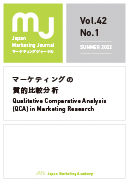Volume 42, Issue 1
Qualitative Comparative Analysis (QCA) in Marketing Research
Displaying 1-13 of 13 articles from this issue
- |<
- <
- 1
- >
- >|
Preface
-
2022 Volume 42 Issue 1 Pages 3-5
Published: June 30, 2022
Released on J-STAGE: June 30, 2022
Download PDF (305K) Full view HTML
Special Issue / Invited Peer-Reviewed Article
-
2022 Volume 42 Issue 1 Pages 6-16
Published: June 30, 2022
Released on J-STAGE: June 30, 2022
Download PDF (513K) Full view HTML -
2022 Volume 42 Issue 1 Pages 17-27
Published: June 30, 2022
Released on J-STAGE: June 30, 2022
Download PDF (578K) Full view HTML -
2022 Volume 42 Issue 1 Pages 28-39
Published: June 30, 2022
Released on J-STAGE: June 30, 2022
Download PDF (850K) Full view HTML -
2022 Volume 42 Issue 1 Pages 40-51
Published: June 30, 2022
Released on J-STAGE: June 30, 2022
Download PDF (640K) Full view HTML -
2022 Volume 42 Issue 1 Pages 52-64
Published: June 30, 2022
Released on J-STAGE: June 30, 2022
Download PDF (645K) Full view HTML
Review Article / Invited Peer-Reviewed Article
-
2022 Volume 42 Issue 1 Pages 65-72
Published: June 30, 2022
Released on J-STAGE: June 30, 2022
Download PDF (470K) Full view HTML -
2022 Volume 42 Issue 1 Pages 73-80
Published: June 30, 2022
Released on J-STAGE: June 30, 2022
Download PDF (448K) Full view HTML -
2022 Volume 42 Issue 1 Pages 81-89
Published: June 30, 2022
Released on J-STAGE: June 30, 2022
Download PDF (505K) Full view HTML
Peer-Reviewed Article
-
2022 Volume 42 Issue 1 Pages 90-100
Published: June 30, 2022
Released on J-STAGE: June 30, 2022
Advance online publication: May 16, 2022Download PDF (612K) Full view HTML
Marketing Case
-
2022 Volume 42 Issue 1 Pages 101-110
Published: June 30, 2022
Released on J-STAGE: June 30, 2022
Download PDF (1436K) Full view HTML
Book Review
-
2022 Volume 42 Issue 1 Pages 111-113
Published: June 30, 2022
Released on J-STAGE: June 30, 2022
Download PDF (314K) Full view HTML
Editorial Note
-
2022 Volume 42 Issue 1 Pages 114
Published: June 30, 2022
Released on J-STAGE: June 30, 2022
Download PDF (616K) Full view HTML
- |<
- <
- 1
- >
- >|
